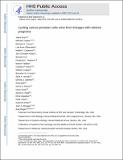Cycling cancer persister cells arise from lineages with distinct programs
Author(s)
Oren, Yaara; Tsabar, Michael; Cuoco, Michael S; Amir-Zilberstein, Liat; Cabanos, Heidie F; Hütter, Jan-Christian; Hu, Bomiao; Thakore, Pratiksha I; Tabaka, Marcin; Fulco, Charles P; Colgan, William; Cuevas, Brandon M; Hurvitz, Sara A; Slamon, Dennis J; Deik, Amy; Pierce, Kerry A; Clish, Clary; Hata, Aaron N; Zaganjor, Elma; Lahav, Galit; Politi, Katerina; Brugge, Joan S; Regev, Aviv; ... Show more Show less
DownloadAccepted version (5.447Mb)
Open Access Policy
Open Access Policy
Creative Commons Attribution-Noncommercial-Share Alike
Terms of use
Metadata
Show full item recordAbstract
Non-genetic mechanisms have recently emerged as important drivers of cancer therapy failure1, where some cancer cells can enter a reversible drug-tolerant persister state in response to treatment2. Although most cancer persisters remain arrested in the presence of the drug, a rare subset can re-enter the cell cycle under constitutive drug treatment. Little is known about the non-genetic mechanisms that enable cancer persisters to maintain proliferative capacity in the presence of drugs. To study this rare, transiently resistant, proliferative persister population, we developed Watermelon, a high-complexity expressed barcode lentiviral library for simultaneous tracing of each cell's clonal origin and proliferative and transcriptional states. Here we show that cycling and non-cycling persisters arise from different cell lineages with distinct transcriptional and metabolic programs. Upregulation of antioxidant gene programs and a metabolic shift to fatty acid oxidation are associated with persister proliferative capacity across multiple cancer types. Impeding oxidative stress or metabolic reprogramming alters the fraction of cycling persisters. In human tumours, programs associated with cycling persisters are induced in minimal residual disease in response to multiple targeted therapies. The Watermelon system enabled the identification of rare persister lineages that are preferentially poised to proliferate under drug pressure, thus exposing new vulnerabilities that can be targeted to delay or even prevent disease recurrence.
Date issued
2021Department
Massachusetts Institute of Technology. Department of BiologyJournal
Nature
Publisher
Springer Science and Business Media LLC
Citation
Oren, Yaara, Tsabar, Michael, Cuoco, Michael S, Amir-Zilberstein, Liat, Cabanos, Heidie F et al. 2021. "Cycling cancer persister cells arise from lineages with distinct programs." Nature, 596 (7873).
Version: Author's final manuscript